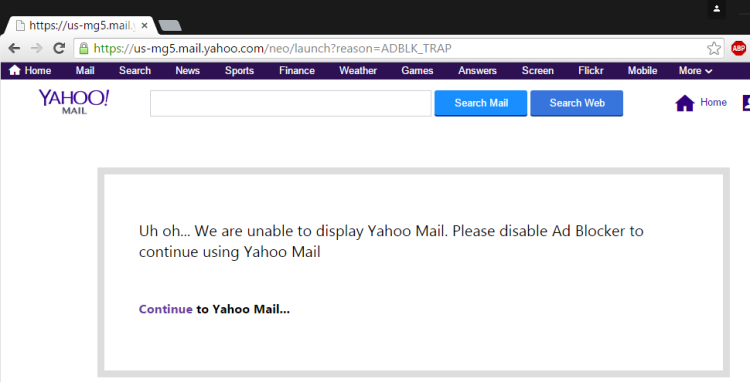Many publishers are wringing their hands over how to get their ads seen when everybody’s using ad blockers on the desktop and on mobile these days.
I’ve spoken with a number of people in the digital advertising business who say the solution is to just deny users with ad blockers access to the content they want. No ads, no content.
That seems to be the very idea behind Yahoo’s test yesterday. A number of mobile users were met with the above message when they tried to access their Yahoo Mail account.
Note that part of the URL reads ADBLK_TRAP or “ad block trap.”
And that, in a nutshell, is the problem. If you’re going to ask people to turn off their ad blocker, you can’t give them a direct order to do so and then call it a trap.
Yes, it’s a communication problem. The message can’t sound punitive. It’s like hearing your Mom tell you: “Eat your green beans or no dessert.” To that, grown up people might react like this:
https://twitter.com/d_batman_b/status/667365044833882113?ref_src=twsrc%5Etfw
I think most web users would be sympathetic to publishers’ need for ads if the ads were not disruptive, distracting, and out of control. And if they’re provided a basic understanding of the economics of the Web.
If a publisher or service provider wants to ask users to ditch ad blockers, they have to start communicating that message long before the user arrives at the page and is surprised by a roadblock. There has to be an advance email (if possible) or some other notification explaining the request.
A contract
Part of that explanation is the offer of a contract between the user and the publisher. The covenant should contain at least these four messages:
Our mobile ads comply with the standards recommended by the Interactive Advertising Bureau.
Whether the ads are display, native, video, or whatever, they have to follow a pre-approved set of formats so as not to interfere with the content the user came to view. The IAB is in the business of providing these standards.
We depend on ad revenue to offer you this content or convenient service. If our ads get blocked, we eventually won’t be able to pay our bills.
There has to be a good reason for the user to turn off the ad blocker, and it has to be about the longevity of the relationship between the user and the site or service.
We see that you’re using the such-and-such browser with the so-and-so browser plug-in. If you are satisfied with the conditions mentioned above, here’s how to turn it off.
The whole thing has to be made simple for the user. The ads are already considered a friction point, so it’s smart to remove all friction from the act of turning off the blocker.
Reminder that publisher or service provider offers an invaluable product to its XXX daily users.
The user should be reminded of what she gets from the site or service — for free — and what she would miss if it were suddenly taken away.
German publisher Axel Springer has already barred readers with ad blockers from reading its Bild tabloid website. Here’s what that looks like:
The publisher communicates most of the key messages well (the big red button goes to instructions for turning off the ad blocker). It could, however, lose the terse tone.
The ad blocking problem has been an issue on the desktop for years, and is just now becoming a big deal for publishers on mobile. Some publishers say they are already shifting ad dollars away from browser display ads (blockable) to in-app ads (far less blockable).
But some publishers, especially smaller ones, will have to continue relying on mobile browser ads. And for them, a clear and meaningful dialog with readers about ad blocking may be the only way forward.
VentureBeat's mission is to be a digital town square for technical decision-makers to gain knowledge about transformative enterprise technology and transact. Learn More


